Search Results for 'Old Galway Society'
34 results found.
The Lion’s Tower
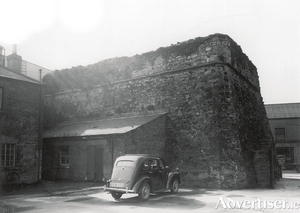
The Lion’s Tower was part of the old city wall. In the last century, it was situated on Eglinton Street between the Garda Barracks and the Savoy Cinema. Our photograph today, which we show you courtesy of the Board of Works, dates from about 1950 and shows the tower as seen from the yard beside the barracks.
advertiser In brief...
City council launches local community festivals grants
Gentian Hill
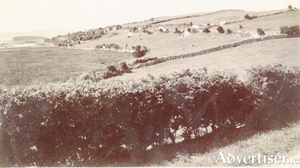
The correct name for this promontory is Blake’s Hill which comprises approximately 30 acres. Gentian Hill was a much smaller area further north, but nowadays the whole area is referred to as Gentian Hill. An extract from O’Donovan’s Letters described it as follows: “Here in Blake’s Hill over the sea, whither the young men of Galway were wont to come on horseback on the third day of their May game, and there dine between the hill and the castle of Barna. Sir Moragh O’Flaherty of Aughamore defeated an army out of Clanricard on the 22nd of June 1564 on the strand at Traybane, Cnoc an Blacaigh.”
Claregalway heroes
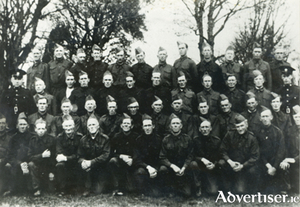
In the years following the establishment of the Defence Forces, various classes of Army Reserves were experimented with between 1927 and 1939. In May 1927, a Class A Reserve was formed consisting of NCOs and men transferred to the Reserve. In January 1928, a Class B Reserve was set up with the object of building up the infantry arm of the Defence Forces. One joined voluntarily, but in doing so, committed to three months initial training and one month’s annual training thereafter. This group had practically ceased to exist by 1934.
One hundred and seventy five years of Mercy education in Galway
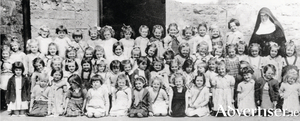
The Sisters of Mercy came to Galway on May 1 1840. They started, in extremely difficult circumstances, in Lombard Street with three postulants. The need for uncloistered sisters who would be free to go about the streets and visit the poor in home, hospital, and jail was very great at the time. They were out and about the day after their arrival. An epidemic of cholera had broken out and they helped to nurse the ill and alleviate distress. They quickly prospered to become “Reputedly the best institution that ever was in Galway”.
St Michael’s GAA Club, sixty years
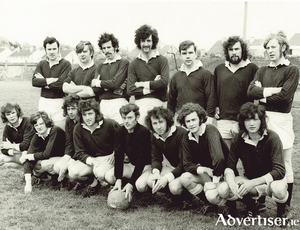
St Michael’s Club was formed in 1956 after Galway won the All-Ireland football final. The first AGM was held in Tom Connolly’s house in Lower Shantalla Road, and they played their first game in 1957. Among those who founded the club were Pa Boyle (whose brainchild it was), Mick O’Toole, John Duignan, Mick Higgins, Liam Cunningham, and Sergeant O’Toole. They started as a dual club, but after a few years they concentrated solely on football.
Galway fires
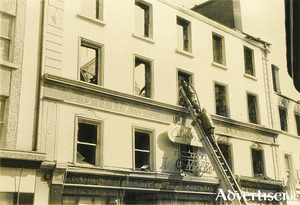
The Connaught Buildings on Mainguard Street originally housed Connolly’s, one of the largest hardware and fancy goods shops in Galway. It had an impressive four storey facade on the front and five storeys on the Church Street side. In 1934 the ground floor was leased by four tenants. A fire started on the first floor, the flames spread rapidly, and smoke could be seen rolling from the building. Half clad figures fought their way bravely down the stairs which threatened to give away any minute. The damage was extensive and estimated at £1,000, but much of the sum was made up of the stock of the ground floor tenants which included a lock-up fruit and vegetable shop rented by Mr P Hennigan. A Mr McDonnell and his brother had a tailoring business on the first floor.
Geraghty’s men’s shop
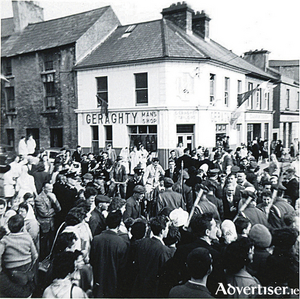
“Good clothes are needed by the men of today and Geraghty & Sons can supply the perfectly tailored suit you need in 4 days. Tailored in our own workshops. Have your clothes made by the men with five generations of Tailoring experience behind them. See our range of suitings, serges and overcoats. 50 shillings, Suit or Overcoat. Customers own materials made up at reduced prices. Special terms for C.M. & T. To the trade. Geraghty & Sons, Lombard St. Galway.”
The Eglinton Canal
One hundred and sixty eight years ago this week, on March 8, work started on the cutting of what we know as the Eglinton Canal. There had been previous attempts to open a passage from the river to the sea. As far back as 1498, the then mayor had a plan to connect the Sandy River with Lough Athalia. It was Alexander Nimmo who first mooted the idea of a canal in 1822. If steamboats could travel from the docks to the Corrib, it would greatly enhance the commercial importance of the city and a valuable connection with the hinterland would be established. His original plan was that this connection would start at the top of Woodquay, where McSwiggan’s is today, go along Eglinton Street and down the west side of Eyre Square to the docks. The cost proved to be prohibitive and there were a lot of objections from people who owned land or a business along the route.
The Proclamation Of King George V
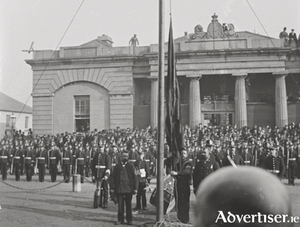
“The accession of His Majesty King George V was proclaimed in Galway at 2 o’clock on Saturday (21st of May, 1910). The ceremony was performed by the High Sherriff, Mr. Cecil R. Henry, and took place opposite the Courthouse. On the steps of the building there was a fashionable gathering. Outside the hollow square formed by soldiers and police, the crowd was one of immense proportions. About one hundred men of the Connaught Rangers, with their band and the King’s colour, under Major Sarsfield, were formed up in line opposite the Courthouse, and an equal number of the Royal Irish Constabulary, drawn from Galway and outside stations, filled up the remaining sides of the square. They were in charge of Co. Inspector Flower, Districts-Inspectors Mercer and O’Rorke.

